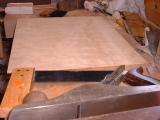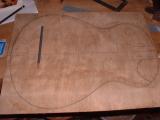Home
Cycling
Aikido
Computers
Music
Photos
Links
Nick's Stuff

A New Guitar
...or two!
Jump to:
Intro
The selected wood
First Steps
The bodies
First Steps
Otherwise known as 'getting your hands dirty'
All the wood has now been planed straight and square, but the Sycamore has proved to be a real troublemaker.
The grain is very tightly curled, and so I've been using a really finely set plane so that I don't tear the grain out.
Unfortunately that means it takes a little longer, and fitting this in around my day job means slow progress.
The Goncalo has a more interlocked grain than I first realised, so that needed careful attention too. The Limba (Korina)
is just beautiful, reminding me of Ash, but with perhaps longer, finer fibres. The plane picks up long fine ribbons, leaving an
almost mirror-like surface, and there seems to be hardly any interlocking of the grain. A lovely wood to plane.
Steve has shown an interest in the idea of a 'Standard' style guitar, so I may end up making two similar ones.
The second job has been to make a master template for the shape of the guitar. This has been done with 1/8" ply,
which should be sufficient.
 This was used to design the body, at 1:1 scale, and the shape and measurements will
then be transferred to the wood for cutting. I could have used CAD for this, but being a hands-on kind of person
I found myself in the workshop with a pencil in my hand before I even thought about switching on the PC!
This was used to design the body, at 1:1 scale, and the shape and measurements will
then be transferred to the wood for cutting. I could have used CAD for this, but being a hands-on kind of person
I found myself in the workshop with a pencil in my hand before I even thought about switching on the PC!
The ply was first set up with a centre line, and then the neck/body joint position was marked. The body shape was then
drawn freehand, sketching the curves, erasing, and correcting until it looked 'right'. The basic dimensions of the Les Paul
were used as a guide, but I haven't been rigid about this.
 When the template is complete with all the markings required (bridge position, pickups etc), it will be cut out on the
bandsaw and used as the pattern for the body wood.
When the template is complete with all the markings required (bridge position, pickups etc), it will be cut out on the
bandsaw and used as the pattern for the body wood.
Making templates and jigs may seem time consuming, perhaps even unnecessary as an amateur, but in the past I've found
that spending a little extra time at the planning stage, or the building of a jig, seems to make the actual job that much easier.
Since I'll be cutting two bodies and (probably) two Sycamore fronts, I think the template is essential. It will allow me to
mark up and cut the timber efficiently, and anything that prevents wastage is a bonus.